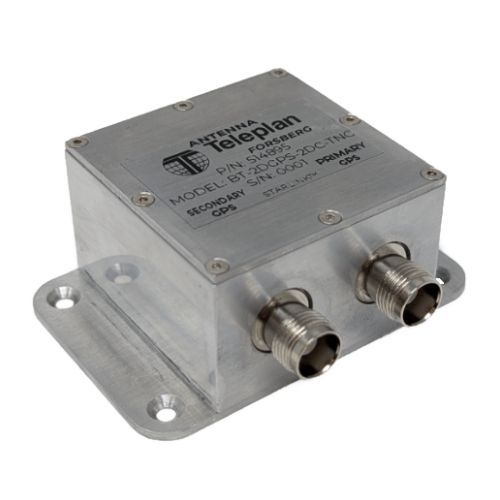GNSS signal splitter
A GNSS/GPS splitter connects an external antenna to two receivers or repeaters simultaneously.
Optimised to pass signals within the GNSS upper L-band frequency range.
What’s the difference between GNSS & GPS?
Rugged construction ensures performance on land, sea or air.
Technical details

- Supports GPS L1, GLONASS G1, Beidou B1, Galileo E1
- Also passes Inmarsat, Omnistar and DGPS beacons
Frequency range: 1420 – 1660 MHz
- Low insertion loss: <4dB
- Connectors: N-Type, TNC or BNC sockets
- Weight: 4 oz, 113 grams
- Temperature range: -40 C to +70 C
- Isolation: Typically >18dB
- Dimensions: 7.62 x 5 x 3.2 cm
- Power supply: powered by GPS receiver
There are two ordering options, depending on the functionality required regarding DC power supply.

GPS signal from the antenna enters the splitter and is passed to both GPS receivers via primary and secondary ports.
The GPS receivers are both providing a DC voltage to power the splitter and the external antenna through the coaxial cable.
DC voltage from the receiver on the primary port passes through to the antenna (DC pass through).
Secondary port doesn’t pass the DC voltage through to the antenna (DC blocked).

GPS signal from the antenna enters the splitter and is passed to both GPS receivers.
The GPS receivers both provide a DC voltage to power the splitter and the external antenna through the coaxial cable.
Receivers on both primary and secondary ports can power the antenna – but only one of them will.
BT-2DGPS-2DC operation
DC voltages from both receivers are monitored by internal circuitry – the highest voltage wins and is passed through to the antenna.
If the same voltage is supplied to both ports, the splitter will randomly select one of them to be passed to the antenna.

This illustration of BT2DGPS-2DC assumes that the GPS antenna can be powered by a DC voltage range that includes 3.3V and 5.0V DC.
If the receiver that is supplying 5V DC fails, or is powered off, 3.3V DC will be passed through to the antenna.
The highest DC voltage will pass through the splitter to the antenna, regardless of whether it is connected to the PRImary or SECondary port.
Ordering options
| Part code | Description |
| BT-2DGPS-N | Receiver powers antenna through primary port; N-type connectors |
| BT-2DGPS-TNC | Receiver powers antenna through primary port; TNC connectors |
| BT-2DGPS-BNC | Receiver powers antenna through primary port; BNC connectors |
| BT-2DGPS-2DC-N | Receiver powers antenna through either primary or secondary port; N-type connectors |
| BT-2DGPS-2DC-TNC | Receiver powers antenna through either primary or secondary port; TNC connectors |
| BT-2DGPS-2DC-BNC | Receiver powers antenna through either primary or secondary port; BNC connectors |
FalTech has access to a range of GNSS antennas and coaxial cable that can be supplied with a GNSS splitter as part of a bespoke solution.
Let us know what your requirements are and we will help specify a system for you.
Also available from Forsberg Services is a comprehensive range of GPS amplifiers
For longer distances between antenna and receiver, where coaxial cable and amplifiers is impractical, consider using a GPS-over-fibre solution.
Need help to decide which system is right for you?
Or call us on

